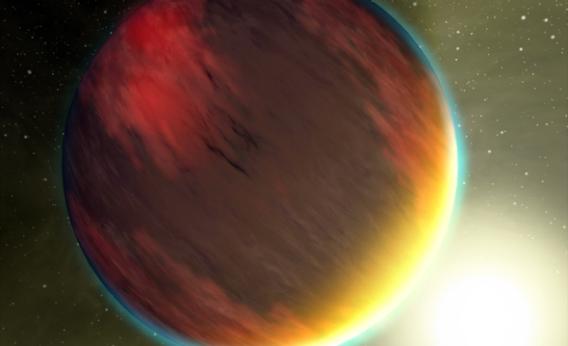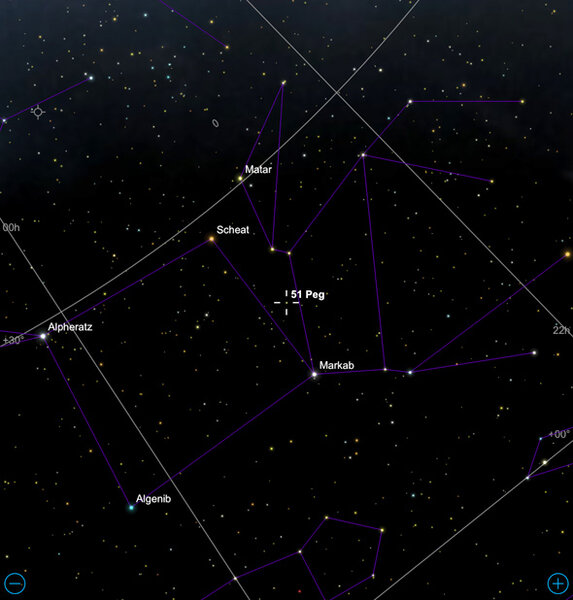Create a free profile to get unlimited access to exclusive videos, sweepstakes, and more!
The 20th Anniversary of Exploring Strange, New Worlds

Twenty years ago, on this very date, the field of astronomy underwent a magnificent revolution.
On Oct. 6, 1995, Swiss astronomers Didier Queloz and Michel Mayor announced they had discovered a Jupiter-like planet orbiting a Sun-like star.
This was the very first time a planet was seen orbiting a “normal” star. Planets had previously been discovered around pulsars—the compact and furiously energetic cores of stars that had exploded. But it’s thought that the planets may have formed after the supernova event that created the pulsar, and besides, pulsars are nothing at all like the Sun.
Still, this new planet, called 51 Pegasi b, was a surprise. A big one! While it had about the same mass as Jupiter, it orbited its host star (51 Peg) in just four days, meaning it was on an orbit a mere 8 million kilometers from the star. Compare that with Mercury, our solar system’s innermost planet, which never gets closer than about 46 million km from the Sun.
This meant 51 Peg b was hot, cooking away at a temperature of about 1,300° C. No one thought a planet that size could be that close to a star. Did I say the discovery was a surprise? I meant it was a shock, one so profound that it was met with deep skepticism.
As well it should! But its existence was quickly confirmed by a team of American astronomers, rivals in the hunt for the first extrasolar planets, as they were once called (we now call them exoplanets).
The planet was found using what’s called the “radial velocity” or reflexive “motion method.” A planet orbits a star due to the star’s gravity. But the planet has gravity, too, so as the planet makes a big circle around the star, the star makes a little circle. In reality both orbit the center of mass of the system, called the barycenter. I describe how this works in my episode of Crash Course Astronomy about the discovery of exoplanets:
As far as we knew at the time, planets like Jupiter had to form far out from their stars, half a billion kilometers or more. Because of this, astronomers who were hunting for exoplanets assumed they would take months or years to make an orbit. They completely missed the presence of 51 Peg b in their data.
Once it became clear these “hot Jupiters” existed, more were found in existing data. Within a few years many more were discovered. It’s now thought they do form far out, but then migrate closer to their star over millions of years. Although they make up only a minority of all exoplanets, these are the easiest to find using reflexive motion; their high mass and close orbit make their signal in the data easiest to see.
Once 51 Peg b was found, the floodgate was opened. HD 209458 b was another hot Jupiter found in 1999, and had an orbit so close to being edge-on that astronomers thought it might actually pass in front of its star, transiting it, dimming its light once per orbit. Careful observations later that same year detected a dip in the star’s brightness (only 1.7 percent!), which gave them the first independent observation of an exoplanet. Any lingering doubts about the existence of these alien worlds evaporated.
The field matured so quickly that NASA launched the Kepler spacecraft in 2009, designed specifically to stare at 150,000 stars to look for transiting exoplanets around Sun-like stars. As of today, Kepler has more than 1,000 confirmed exoplanets under its belt, and well over 3,000 more waiting confirmation.
We’ve seen planets big and small, hot and cold, orbiting small cool stars, huge hot stars, multiple stars, and even in systems with multiple planets.
When I was a kid—heck, when I was in grad school—the only planets we knew of were the ones in our solar system. Using simple statistics, we now think that planets outnumber stars in the galaxy and that most stars may have planets. There may be tens of billions of Earth-size planets in our galaxy alone!
But we had to start somewhere. Exactly two decades ago, 51 Peg b gave us that start.
The host star, 51 Peg, is close by, just 50 or so light-years from us. It’s actually very much like our Sun, just a hair more massive, hotter, and bigger. It’s visible to the naked eye, barely, from a dark site. The constellation of Pegasus is high in the night sky for Northern Hemisphere observers right now, in fact. If it’s clear where you are, and you have a pair of binoculars, why not take a look at it tonight?
I will. The exoplanet is completely invisible to even the largest of telescopes, drowned by the light of its oh-so-close star. But who knows: Maybe a photon or two from the planet itself will pass into your eye as you look at the star, absorbed into your retina.
The sky may be brimming with planets. We stand on one among billions. And if you look, a small spark, literally the tiniest reflection of one, could become a part of you.



























